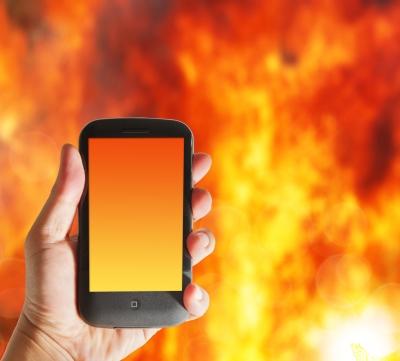If you pay attention to headlines it’s likely that you’ve seen that Li-ion or “lithium” batteries are causing big problems with the Samsung Note 7 phone. The issue has become so serious, that airlines are banning the use of the phone on flights and Samsung has recalled all the Note 7 phones and halted sales of even the replacement models(the replacement are also having battery issues!). These phones and all modern cell phones use batteries that rely on lithium, and are popular because they are light in weight, compact in size, can charge fast and have the abilities to store enormous amounts of energy. They do well in an environment where they are constantly charging and discharging, and these properties are why you find them in cell phones, laptops, cameras, electric cars, portable tools and all kinds of electronic devices.

Why are Lithium Ion Batteries Causing Fires?
Sadly, they malfunction only periodically, but when they do, the results are so overwhelming that it appears in headlines all around the globe. Generally, this is because they tend to catch fire or even explode.
Why Are They Exploding or Catching Fire?
Just why they do this is relatively simple to understand. The standard lithium battery uses two electrodes that are kept separated by an electrolyte. The batteries will take their energy from a lithium metal cathode delivered through an organic solvent, traditionally lithium salts. This moves the energy to a carbon anode. That is technical speak, but it explains the energy transfer and the materials in the lithium batteries. If you’re interested in learning more specific details, then read our article here: How Batteries Work.
Now, why do they burst into flame? The specifics of how this happens varies based on the batteries themselves. Most have a partition that prevents the lithium ion from coming in direct contact with the anode. The entire battery itself is a pressurized unit, if the partition is punctured, the lithium’s direct contact with the anode causes a reaction that generates a high amount of heat, sometimes creating a rupture of the phones enclosure or producing a fire.
Beautiful but Flawed Design
Why would a battery sustain a puncture of the partition? It has to do with that need for them to be lightweight. This means that everything about them – from their housings to their interior partitions, are thin and somewhat fragile. Almost anything on a lithium battery can rupture or be punctured, when these batteries are harmed, damaged or have the slightest design or manufacturing flaw. In the situation with the Samsung Note 7, it appears that a manufacturing defect has caused a weakness in the separator between the anode and the cathode, creating some dangerous outcomes for quite a few of the phones.
Batteries in devices like laptops and cellphones can also become overheated, and can heat to a level known as “thermal runaway”. This creates even more pressure in the battery, and it too might result in an explosion.
In 2015, the Boeing company actually grounded its entire fleet of Boeing 787s because of lithium battery fires. They only returned to the skies once every plane had been fitted with modified systems offering protection to the planes if battery fires once again broke out.
The vulnerability of the batteries is another reason that they no longer can be shipped in cargo holds of airplanes. In April 2016, the U.N.’s International Civil Aviation Organization enacted a ban on bulk shipments of the batteries, but still allows travelers to board or stow devices that rely on lithium ion batteries.

Most lithium battery powered devices will never have a problem. Just, don’t sit on that phone!
In late 2015, it was reported that more than 50 fires had broken out due to the lithium batteries at work in hoverboards. These Back to the Future inspired devices have created a lot of controversy, along with their safety risks. Because they have problems with charging as well as with rugged usage, they have become the focus of consumer agencies pointing out the risks of lithium batteries.
Should you worry that the cell phone in your pocket or the battery in your laptop is putting you at risk? For the most part, no. This is because batteries and chargers on most devices have already been safely certified. Additionally, as we discover the causes of each of these battery failures, that knowledge is used to prevent future problems. The lack of standards for a device as unique as hoverboards is what has allowed it to slip through the safety certification process. Avoid the use of the problem devices for now, and simply remember that your lithium ion batteries are actually quite vulnerable if the are misused or abused.
You’ll also like:
How do Batteries Work?
Could we use Old Cell Phones to Power our Homes…our Cars?
Sanyo Eneloop Power Pack Rechargeable Battery Kit Review

Leave a Reply